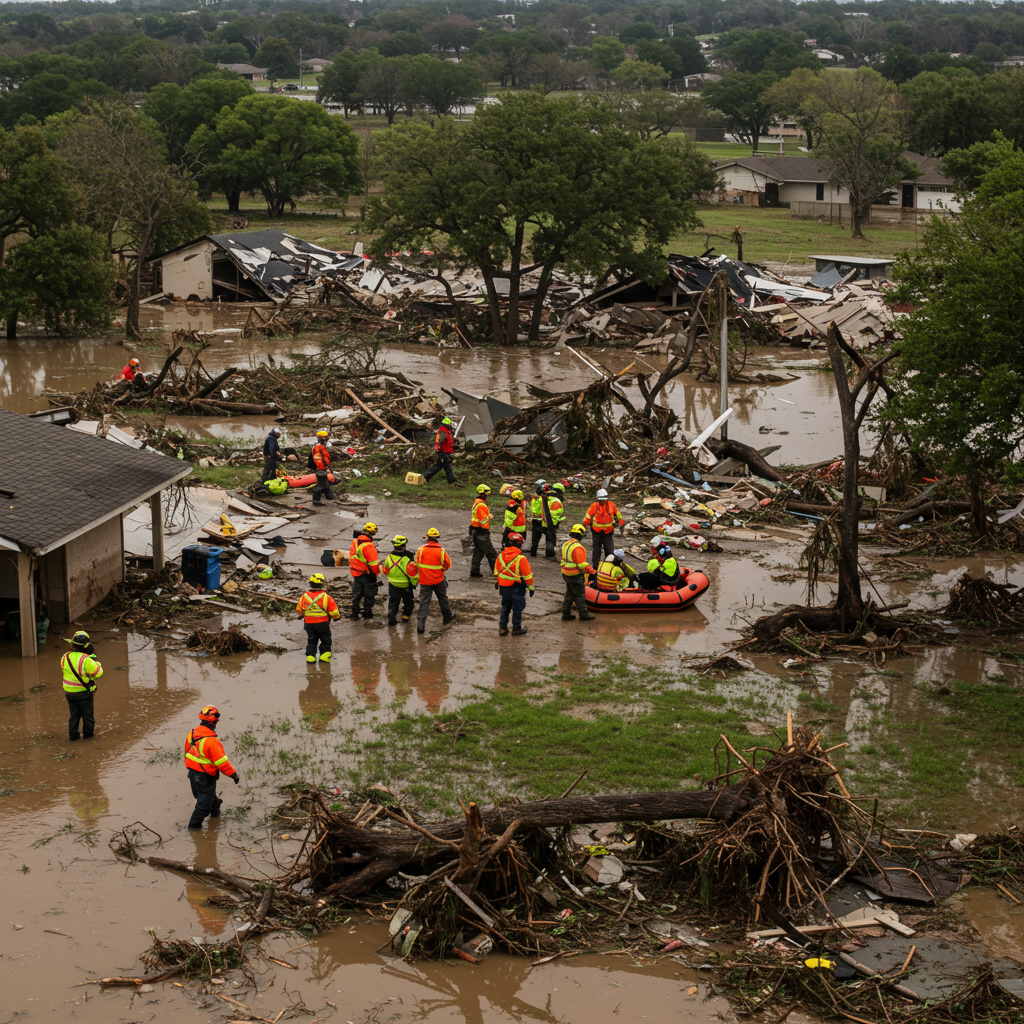A devastating flash flood event has tragically claimed at least 78 lives in central texas, with dozens more people still unaccounted for. The disaster, which unfolded rapidly following intense storms, has triggered one of the most significant search-and-rescue operations in recent Texas history. As officials continue navigating challenging conditions, the focus is now heartbreakingly shifting towards recovery efforts three days after the initial inundation. The profound impact of this tragedy is felt most acutely in Kerr County, where families and communities grapple with unimaginable loss.
The heart of the devastation lies in Kerr County, accounting for the vast majority of fatalities. Sixty-eight confirmed deaths have occurred here, a staggering number that includes 28 children. This area, known for its scenic rivers, became the epicenter of the crisis after water levels rose with terrifying speed.
The Catastrophe’s Sudden Onslaught
The disaster struck before dawn on Friday, catching many residents and visitors completely off guard. The Guadalupe river, a central waterway in the affected region, experienced an almost unbelievable surge. Officials reported the river rose a staggering 26 feet (8 meters) in an astonishingly short span of just 45 minutes. This wall of water swept through riverbanks and low-lying areas while most people were asleep, leaving little to no time for escape.
A major focus of the tragedy is Camp Mystic, a popular Christian girls’ summer camp located directly on the banks of the Guadalupe River in Kerr County. The camp was directly in the path of the surging floodwaters. Many young campers and staff were caught inside as the deluge hit. The speed and force of the water caused immense damage to the camp structures and surrounding areas.
Camp Mystic Tragedy Unfolds
The impact on Camp Mystic is particularly poignant. Several young girls attending the summer program are confirmed among the dead. The camp’s longtime director, Richard “Dick” Eastland, also tragically perished in the flood. The scale of the loss at the camp is still being determined. Currently, ten girls and one counselor from Camp Mystic remain missing, contributing to the overall number of unaccounted individuals.
The scene along the river near the camp and connecting areas is one of widespread destruction. A two-lane highway linking Kerrville to Camp Mystic shows the raw power of the flood. Ravaged homes stand surrounded by fallen trees and scattered debris. Furniture lies strewn across what were once manicured lawns. Fences are toppled, and utility lines lie dangerously downed in many locations, complicating relief efforts.
Shifting From Search to Recovery
In the immediate aftermath of Friday’s flood, authorities launched an extensive search-and-rescue operation. This massive undertaking involved numerous agencies and volunteers combing through devastated areas. However, as the days have passed, the grim reality of the situation has necessitated a shift in strategy. Three days after the catastrophic event, officials have transitioned the primary effort from searching for survivors to recovering the bodies of those lost.
This recovery operation is fraught with challenges. Rescue teams are navigating through thick mud, tangled debris, and the wreckage of homes and vehicles. The conditions are treacherous and physically demanding. Compounding the difficulties is the presence of natural hazards in the flood-affected zones, including venomous snakes displaced by the water.
Obstacles and Lingering Dangers
The search and recovery process faces further potential setbacks. Forecasts indicate that more storms are expected to hit the region within the next 24 to 48 hours. Additional rainfall could lead to rising water levels, creating new hazards and potentially hindering the movement and work of recovery teams. This looming weather threat adds another layer of urgency and danger to an already perilous task.
The scale of the loss also presents challenges in identifying victims. Among the bodies recovered specifically in Kerr County, eighteen adults and ten children had not yet been formally identified as of recent reports. This underscores the chaotic nature of the disaster and the difficult process of bringing closure to grieving families. Authorities are working diligently to identify all victims and notify next of kin.
Widespread Impact and Unknown Scope
The devastation extends beyond the immediate vicinity of Camp Mystic. Volunteer rescuers participating in the recovery efforts have reported finding victims significantly downstream from where the camp stood. Greg Froelick, a former Navy Seal volunteering with a rescue group, shared accounts of finding bodies up to eight miles downriver. He described seeing “clothing and items from the camp dressers scattered everywhere, up and down the river,” illustrating the immense force of the floodwaters and how far debris and victims were carried.
There is also considerable uncertainty surrounding the total number of people impacted. The flood occurred during the Fourth of July weekend, a time when many people would have been camping, visiting, or staying in homes along the river. Authorities acknowledge there is no clear count of how many individuals may have been in the area specifically for the holiday and potentially swept away by the floods. Determining the full scope of the missing population remains a significant challenge.
Official and Community Response
In the wake of the disaster, state and federal officials have rapidly mobilized resources. Texas Governor Greg Abbott toured the affected region to survey the damage firsthand. He publicly vowed the state would spare no effort in the search and recovery process. “Authorities would ‘stop at nothing’ to ensure every missing person is found,” Governor Abbott stated, emphasizing the commitment to locating all those still unaccounted for. Visiting the area, he described witnessing the impact on young victims as “nothing short of horrific,” acknowledging the immense trauma experienced.
At the federal level, President Donald Trump signed a major disaster declaration for Kerr County. This crucial step activates assistance from the Federal Emergency Management Agency (FEMA), unlocking federal resources to aid in the recovery and rebuilding efforts. President Trump commented on the event from New Jersey, calling it “a horrible thing that took place, absolutely horrible.” He indicated plans to visit the state later in the week to assess the situation directly and meet with affected communities and officials.
Local Heroes Step Up
Amidst the official response, local residents are demonstrating incredible resilience and community spirit. People from surrounding areas are stepping up to provide vital support to those displaced and the tireless volunteers working on the ground. Relief efforts initiated by locals include collecting essential supplies, offering temporary shelter to those whose homes were destroyed, and providing food and comfort.
Examples of this community generosity abound. Alma Garcia drove from the city of San Antonio specifically to deliver home-cooked meals to residents impacted by the flood and the volunteers engaged in the arduous clean-up efforts. Witnessing the immediate needs, she even reportedly gave a shirt off her back to someone wet and in need, explaining, “She was all wet, I told her she’s going to need it.” Similarly, a local resident named Perla began collecting clothes and shoes immediately after finishing her work shift on Friday. She quickly organized the donations and delivered them to a shelter the very next morning, remarking, “I’ve never seen something like this before,” a sentiment echoed by many witnessing the unprecedented damage.
International Condolences Pour In
News of the devastating Texas floods has resonated globally, drawing expressions of sympathy and support from around the world. Leaders and individuals worldwide have offered their condolences to the victims and their families. Among these messages, Pope Leo XIV offered special prayers during his Sunday address in Rome for those affected by the tragedy.
The pontiff specifically extended his “sincere condolences to all the families who have lost loved ones,” particularly mentioning “their daughters who were in summer camp,” referring to the terrible loss at Camp Mystic. He expressed sorrow for the disaster caused by the “flooding of the Guadalupe River in Texas in the United States” and concluded by stating, “We pray for them,” highlighting the global humanitarian concern following the event.
Frequently Asked Questions
What caused the sudden rise of the Guadalupe River during the Texas floods?
The article states the Guadalupe River experienced an incredibly rapid and drastic rise due to flash floods. It reports the river rose by 26 feet (8 meters) in just 45 minutes. This sudden surge was caused by intense storm activity in the central Texas region. The speed of this water rise was a critical factor in the scale of the disaster, leaving people little time to react or evacuate.
Where were the Texas floods most severe, and what specific locations were impacted?
The most severe impact of the Texas floods occurred in Kerr County, which accounted for the vast majority of confirmed deaths. A specific location heavily impacted was Camp Mystic, a Christian girls’ summer camp located on the banks of the Guadalupe River in Kerr County. The river’s rapid rise directly deluged this camp and the surrounding areas along the riverbanks, including a two-lane highway connecting Kerrville to the camp.
What is the current status of search and recovery efforts in the Texas flood disaster area?
Three days after the initial flood inundation, the large-scale search-and-rescue operation has transitioned into a recovery operation. Rescue teams are actively working to recover bodies from the mud and debris. These efforts are challenged by difficult terrain, potential hazards like venomous snakes, and the forecast of more storms. Officials anticipate the death toll could rise as recovery efforts continue, and they are also working to formally identify recovered remains.
Conclusion
The central Texas floods represent a profound natural disaster with a tragic human cost. As the death toll stands at least at 78, and dozens remain missing, the focus has necessarily shifted from search to the difficult task of recovery. The devastation at locations like Camp Mystic highlights the speed and ferocity of the floodwaters. While official responses from Governor Abbott and President Trump have activated critical aid, the enduring spirit of local residents and volunteers offering support underscores the strength of community in the face of adversity. The path to recovery and rebuilding in the affected areas will be long and challenging, marked by ongoing efforts to find all those lost and to begin healing from this immense tragedy.



